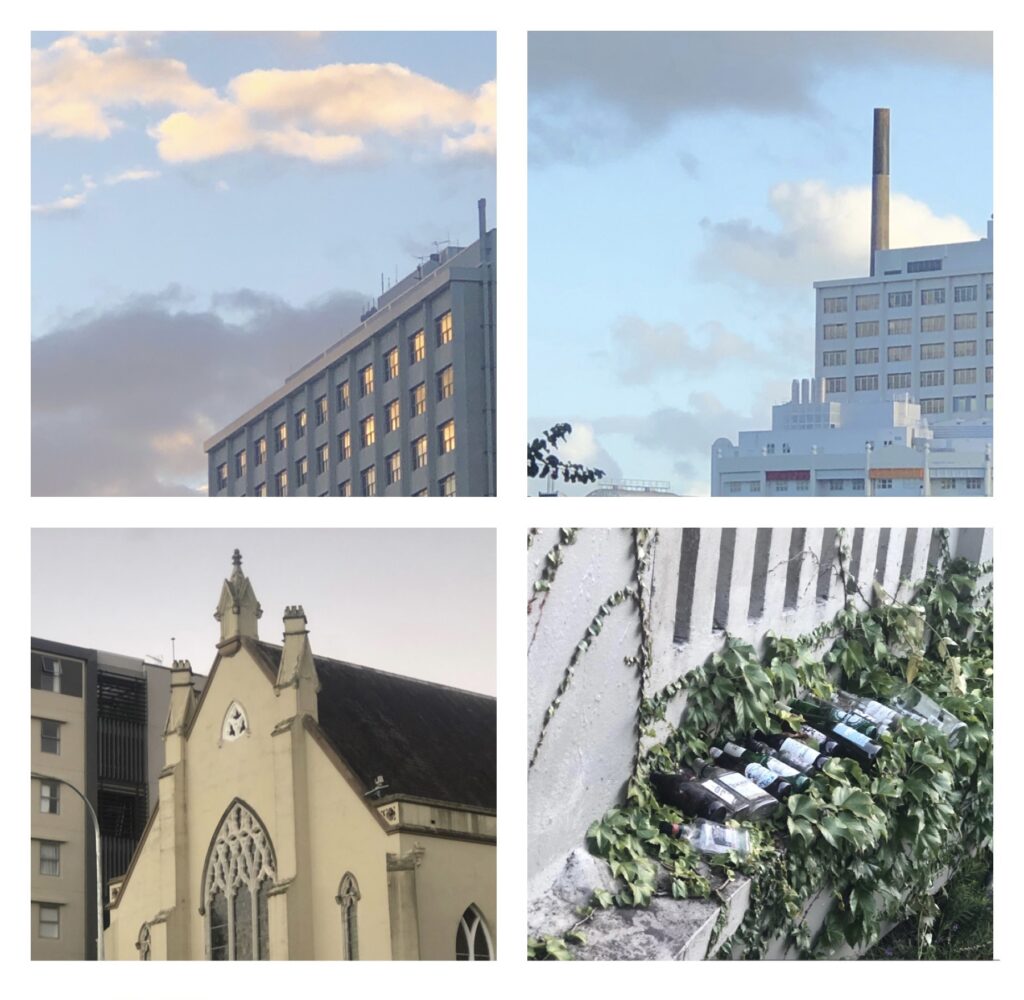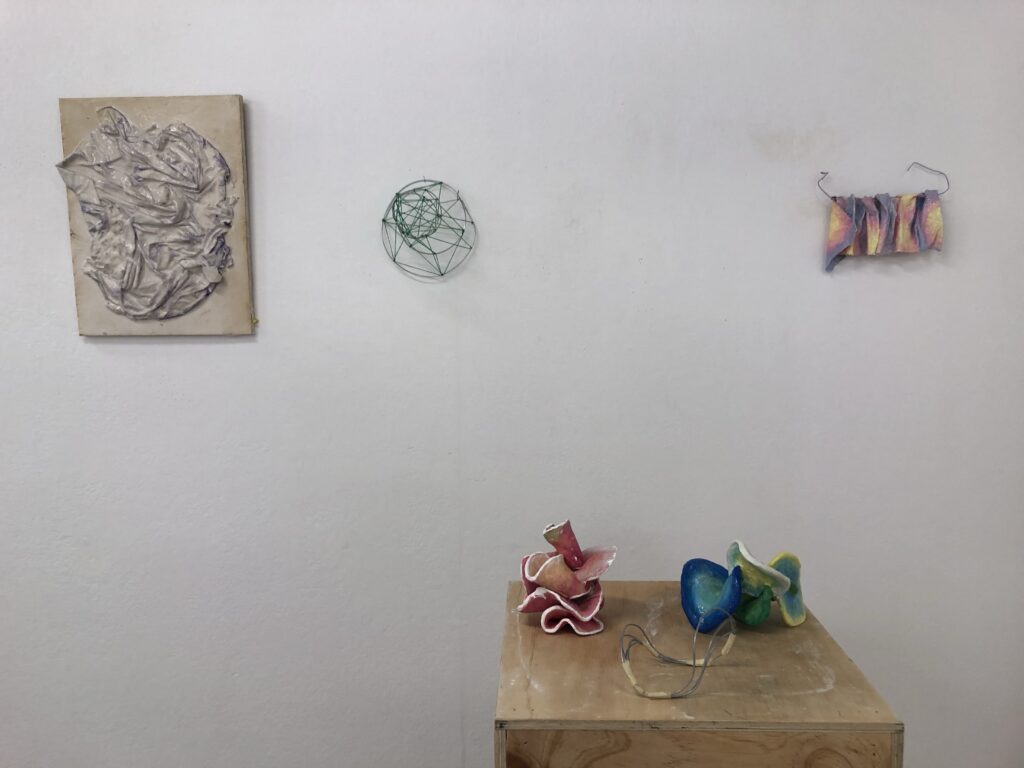While walking Karangahape Road and taking photos in response to my current works with a film camera. I decided out of curiosity to take the photos on my phone to compare differences in lighting, contrast, exposure and the impact colour has in relation to the energy and emotion in a photograph. After analysing key differences between photos, the interpretation of an image is heavily dependant on aspects such as exposure, colour/ black and white, contrast, saturation, camera angle, foreground etc. These aspects intertwine together when breaking down and analysing photos.

In this example there are major differences at a first glance, this presents an instant difference between the resources used to capture these images. The first image shows a vibrant green light that shines through stained glass windows of a nearby building, this light then draws your eyes to the door in the very centre of the setting. The door being the darkest area of the image, shows contrast and creates a resting place for the eye on the image. The green lighting and door being the centre ideation of this photo, together gives a less intimidating presence; creating curiosity for what you might enter into. Amongst this image we notice small details, giving a concise energy to the viewer alongside; details such as moss, aged bars on windows, rust and tagging embeds the idea that this area has been neglected. Overall this image is captivating and welcomes curiosity.
The second image has a lower contrast, already changing perspective it gives to the viewer as opposed to the first photo; feeling much softer and less harsh. Using a film camera removes colour and smaller details in the photo, opening the mind to deeper thinking of the few details present. Upon viewing this image your attention is drawn to the lighting in the top centre, looking as if its almost glowing, illuminating another area of Karangahape road. Thoughts around this lighting originate a theme of a lively setting. These analysations lead your thoughts to question ‘what time is this photo taken’? In addition to ‘what is happening in the surroundings’? The open door being a key subject matter in the first photo is perceived in an alternate way in the film version; alongside the lighting above it, gives the idea that this building is occupied, though the open door leads to a dark room, having us question ‘what is beyond the door’? ‘Who is beyond the door’? Why is it so dark’. Green lighting within the first photo softened the intimidating and foreboding sense within the image, whereas the film version has no aspects to soften this idea. Use of a disposable film camera has provided an effective outcome, giving insight to how various resources effect the final result. Having taken away small details we are given a the opportunity to broaden our mindset on how to perceive this image.

When observing these two photos together, major differences aren’t present, though upon breaking it down there are small details giving seperate narratives and themes to both. The green paint is the first key aspect that is noticed and gives the image a base theme to build on. Combination of clearly aged green paint, tagging and words ‘Artspace Studio’, create a narrative that this image is captured in the setting of a creative area, feeling immensely casual and relaxed. The low contrast and high vibrancy of colour in this image assists in the idea of this photo being casual and relaxed. There isn’t a large amount of foreground, giving use little context to the surroundings, once again, allowing our mind to have more creative freedom when establishing our own personal narrative towards this image.
The first notable difference in the second image is that is it black and white, this takes away the from the aged green paint and the narrative that stemmed from this. The film image in comparison the the colour image has more foreground within the image, we’ve allowed for more of an entrance way. The low contrast softens the feeling of the image, there is no harsh black or white in the image aside from the entrance sign. The solid white on entrance sign emphasises my concepts and themes I’m exploring within this brief, alongside the extra foreground we find this image to focus on the action of entering unlike the other photo, theres less curiosity in discovering what’s beyond the door. The word ,Artspace, and tagging does encourage my previous concept in the colour image, that this photo is taken in a creative setting. The tagging when noticed in detail, has a rough circle around the door knob, pushing our curiosity to what is behind the door. The tagging when noticed in detail, has a rough circle around the door knob, pushing our curiosity and interest to, what is behind the door?

Analysing the first image we notice stairs leading to a door. Two different sections in this image are recognised, the plain concrete wall with the door and the brick wall below. This image appears quite simple, though is cluttered with texture, tagging and rust, giving character and creating a unique feel for the image. Once again it appears to be in a neglected setting and quite run down, we sense there is some history to this setting, we can recognise this through the small details of rust, tagging and the condition of the building.
The film image at a first glance in comparison to the first image, more foreground is apparent, giving more narrative when reflecting back on the image. This image is viewed more on an angle, as if you are standing there yourself, alongside with the car and empty crates the image feels less neglected and empty. The low contrast with the photo taken from further back I find this image to be more interesting and appealing to the eye as there’s more opportunity for context and ideas to be taken from the image. A centre focus on this image in the door at the top of the stairs, the difference in the walls in relation to the door creates this centre focus as there’s no details in the top half of the image. Leading a natural curiosity as to what is to be discovered beyond the door.
There images specifically give a great example as to why I took two versions of each image, there are many aspects that affect a narrative and theme of an image. I found the film image to appear as a development of the colour image, pushing my ideas and concepts further, allowing to for an easier break down and analysation.
























